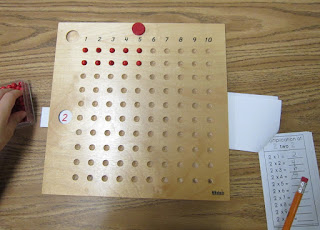Multiplication work is always a favourite activity in our classrooms. The second and third year students have been working with a flurry of multiplication materials - the golden beads, the multiplication bead bars, the stamp game and the multiplication operations boards to name a few. The clear favourite is the multiplication (bead) board.
The multiplication (bead) board is a square wooden board with one hundred little dimples carved into the wood in rows of ten. Across the top of the board are the numbers one to ten. There is a small grooved circle to the left of these numbers in which a small red marker rests when not in use. Half way down the board on the left hand side is a little slot for a number card to be slid into. A cut out circle window allows the number to be seen. The white cards are numbered one to ten. There are also exactly one hundred small red beads for counting.
Before I get to how this material is used, it is important to discuss the language used. It differs slightly from more traditional methods. The language is the key. Instead of saying multiplication is two times four, we would say that multiplication is a number taken many times. In this way, we would say two taken four times.
So how does this material work? When this material is introduced, the child would be given a multiplication booklet consisting of ten pages. Each page illustrates a multiplication table one to ten. (The child in these photographs has already completed a book and wanted to work on his ten times tables.)
In this first photograph the child is working on ten taken three times (10 x 3). The side window has the number ten in it to indicate it is the ten times table. The child begins by setting out ten beads under the number one. They then set out ten beads under the number two and then the number three. The little red marker in this picture is at the top of the board above the three. This tells the child where they must stop when setting out the beads. Next they count all the beads laid out and write their answer ten taken three times equals thirty.
The second photograph shows the child moving on to ten taken four times. The little red marker is now above the four.
The greatest challenge of this work is in the counting. The child must be able to count up to one hundred. The other challenge is making sure the beads are placed securely in the grooves. If they are not, they have the tendency to roll off tables and all over the floor. The other children in the classroom are only too happy to help look for the little red beads. When you see a group of children crawling on the floor looking for red beads, it is time to step in and thank them for their great help.




No comments:
Post a Comment